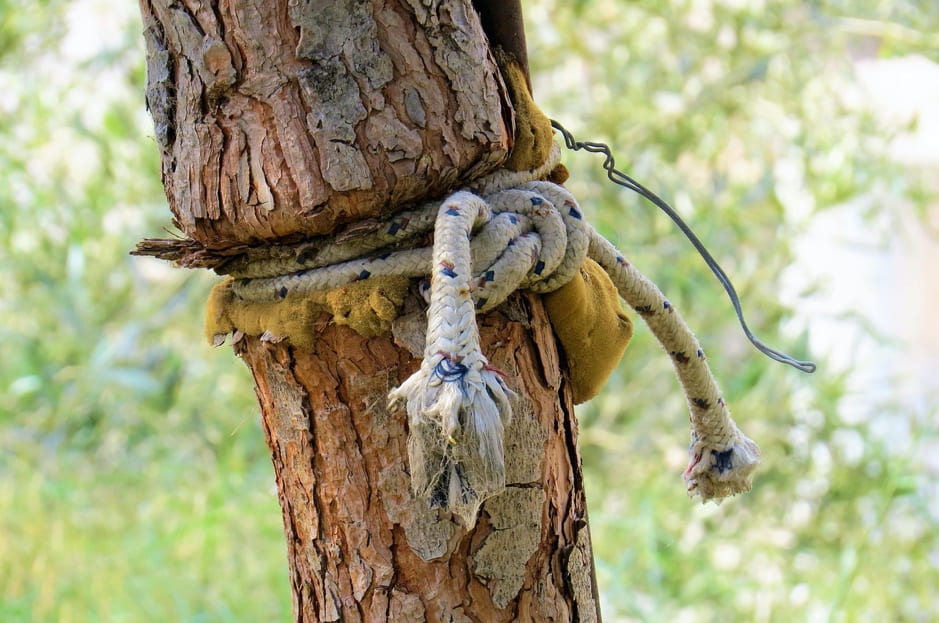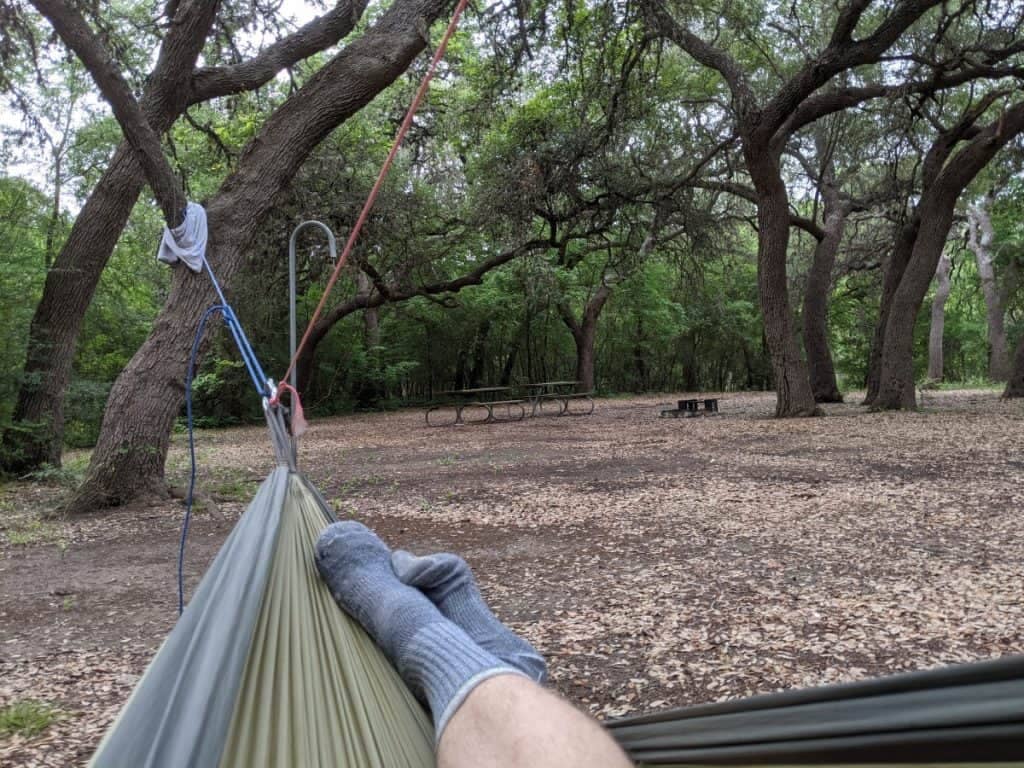Hammocks are a great way to relax outdoors, but many people don’t realize that they can be bad for trees. When you hang a hammock from two trees, it puts a lot of pressure on the bark and can damage the tree over time. In addition, the ropes or straps that are used to secure the hammock can also cause damage.
If you’re going to use a hammock, be sure to choose trees that are strong and healthy, and take care not to damage the bark.
There’s a lot of debate surrounding whether or not hammocks are bad for trees. Some people argue that the weight of the person in the hammock can damage the tree, while others claim that hammocks are actually good for trees because they help aerate the soil around the roots. Personally, I don’t think there’s a clear-cut answer.
If you’re going to hang a hammock from a tree, just be sure to do it carefully and not put too much stress on the tree. In general, I think it’s best to err on the side of caution and avoid hanging Hammocks from very old or fragile trees.
Do Hammocks Harm Trees?
How Do You Hang a Hammock Without Damaging a Tree?
Hammocks are a wonderful addition to any home. They provide a great place to relax and enjoy the outdoors, but they can also be damaging to trees if not hung properly. Here are some tips on how to hang a hammock without damaging a tree:
1. Use straps or rope that is soft and will not cut into the bark of the tree. 2. Avoid using metal hooks or anything else that could potentially scratch or gouge the bark. 3. Do not tighten the hammock too much – it should be snug, but not tight.
This will help avoid putting too much pressure on any one spot on the tree. 4. Check regularly to make sure the hammock is still securely in place and has not damaged the tree in any way.
Read also: Is It Bad to Sleep in a Hammock Every Night
Do Hanging Hammocks Damage Trees?
Hammocks are a wonderful way to relax and enjoy the outdoors, but some people worry that they may damage the trees they are hung from. While it is true that hammocks can cause some damage to trees, as long as you take a few simple precautions, this damage can be minimized. When choosing a spot to hang your hammock, look for two strong trees that are at least 10 feet apart.
Avoid hanging your hammock from dead or dying trees, as they are more likely to break under your weight. If you must hang your hammock from live trees, make sure to use tree straps rather than rope, as the rope can cut into the bark and cause long-term damage. Once you have found the perfect spot for your hammock, take care not to swing too wildly or put all of your weight in one spot.
Swinging back and forth can actually help aerate the roots of the tree and promote growth! But putting all of your weight on one side of the tree can break branches or uproot small trees entirely. So sit back, relax, and enjoy your hammock – just be sure to do so safely!
How Do You Protect Trees from Hammocks?
When setting up a hammock, be sure to follow these tips to avoid damaging trees:
– Use tree straps or webbing, not ropes. Ropes can damage tree bark and lead to the tree’s eventual death.
– Place straps around the trunk of the tree, not over branches. This will help avoid putting unnecessary stress on the tree.
– Avoid using nails, screws or anything else that would penetrate the bark.
This can also damage the tree and lead to its eventual death.
How Far Should a Tree Be from a Hammock?
In order to ensure that your hammock is sturdy and safe, it is important to pay attention to the distance between your tree and your hammock. The general rule of thumb is that the trees should be about 10-15 feet apart from each other in order for the hammock to be safely secured. However, this can vary depending on the size and weight of the hammock as well as the type of tree you are using.
For example, if you have a smaller hammock, you may be able to get away with having the trees closer together than if you had a larger hammock. Additionally, certain types of trees (such as palm trees) have thinner trunks which means they may not be able to support as much weight as other types of trees. Therefore, it is always best to err on the side of caution and make sure that there is plenty of space between your Hammock & Tree!

Credit: trees.wustl.edu
Leave No Trace Hammock Straps
In the world of backpacking and camping, there is a saying: Leave no trace. This means that when you are in the wilderness, you should do your best to leave no evidence of your presence. This includes packing out all of your trash, being careful with fire, and respecting wildlife.
It also means being careful not to damage the environment around you.
One way to help practice leave no trace principles is to use hammock straps that don’t damage trees. When you set up your hammock, you will need to wrap the straps around two trees.
If the straps are too tight or made of materials that can damage the bark (such as nylon), it can harm the tree. Look for Hammock Straps that are adjustable and made of materials that won’t damage trees, such as polyester or Dyneema. By using these types of straps, you can help protect the environment while still enjoying your hammock!
Hammock Tree Straps
We often think of hammocks as being synonymous with summertime and relaxation. But did you know that hammocks can be enjoyed year-round? That’s right, even in the winter!
Hammock Tree Straps are a great way to enjoy your hammock in any season. Hammock Tree Straps are made of durable polyester webbing and have metal S-hooks on each end. They easily adjust to fit around any tree, post, or sturdy object.
Each strap has a load capacity of 250 lbs, so you can be sure they’re safe and secure. And best of all, they make it quick and easy to set up your hammock – no need for complicated knots or ropes. Just wrap the strap around the chosen object and clip it into place.
In no time at all, you’ll be kicking back and enjoying the view! Whether you’re looking to relax in your backyard or take your camping setup to the next level, Hammock Tree Straps are a must-have accessory. So don’t wait – pick up a set today and start enjoying your hammock all year long!
Hammock Tree Protection
Hammocks are often associated with relaxation and tropical breezes, but did you know that they can also be used to help protect trees? That’s right – hammock tree protection is a thing!
There are many reasons why you might want to consider protecting your trees with a hammock.
For one, it can help to keep them healthy by preventing damage from things like lawnmowers or other yard equipment. Additionally, it can also extend the life of your trees by providing shade and shelter from harsh weather conditions.
So how do you go about setting up a hammock for tree protection?
The first step is to choose the right size and type of hammock for your needs. There are many different options available on the market, so be sure to do your research before making a purchase. Once you’ve got your Hammock, the next step is to find two strong and sturdy trees that are spaced far enough apart to accommodate it.
Once you’ve done that, simply follow the instructions that came with your Hammock to set it up properly. And that’s all there is to it!
If you’re looking for an easy way to help protect your trees, then consider using a hammock.
It’s a simple solution that can make a big difference in the health and longevity of your trees!
Will Putting a Hook in a Tree Kill It
Will Putting a Hook in a Tree Kill It?
No, putting a hook in a tree will not kill it. The bark of the tree will grow over the hole left by the hook and eventually heal.
However, if you put a lot of hooks in the same tree, or if you put them too close together, it could damage the tree and make it more susceptible to disease or pests.
Hammock to Hang between Trees
If you’re looking for a relaxing way to spend time outdoors, consider hanging a hammock between two trees. This popular activity is a great way to enjoy the fresh air and take in some stunning scenery. Here’s everything you need to know about hanging a hammock between trees.
First, choose two trees that are the right distance apart. You’ll want to make sure the hammock has plenty of room to stretch out without being too tight. Next, find sturdy tree branches or trunks to use as anchor points for your hammock.
Once you’ve found the perfect spot, it’s time to set up your hammock. If you’re using an open-air hammock, simply tie each end of the hammock around the tree trunk or branch. For more protection from the elements, look for a camping hammock with mosquito netting or a tarp included.
These types of Hammocks will have loops or hooks at each end that can be easily attached to trees. Once your Hammock is all set up, it’s time to relax and enjoy! Be sure to take in all the sights and sounds of nature while you swing in your own personal paradise.
Tree Saver Straps
If you’re a tree lover, then you need to get your hands on some tree-saver straps! These handy little devices are designed to help protect trees from being damaged by heavy machinery. Tree saver straps are made of high-strength webbing and can be used to secure equipment to trees without harming the bark or foliage.
Whether you’re a professional arborist or just someone who wants to do their part in protecting trees, tree-saver straps are a must-have item. So don’t wait any longer, get yourself some tree-saver straps today!
Hammock Stand
When it comes to hammock stands, there are a few different options to choose from. Some people prefer the traditional hammock stand that is made out of wood, while others prefer the more modern and sleek metal stand. There are also a variety of different sizes to choose from, so you can find one that is perfect for your needs.
However, choosing the right hammock stand is not always as simple as it seems. Here are a few things to keep in mind when selecting a hammock stand: The first thing you need to consider is the weight capacity of the stand.
This is important because you don’t want to purchase a stand that isn’t able to support the weight of your hammock and you. Make sure to check the weight limit before making your purchase. The next thing you need to think about is the height of the stand.
You want to make sure that it is tall enough so that you can comfortably get in and out of your hammock without having to worry about hitting your head on anything. However, you also don’t want it to be too tall that it becomes unstable. Finding the right balance is key.
Finally, take into consideration where you will be placing your hammock stand. If you plan on using it indoors, then make sure that it will fit through any doorways or staircases. If you plan on using it outdoors, then make sure that it can handle being in direct sunlight or rain without rusting or becoming damaged.
Tree Hammocks
A tree hammock is a type of hammock that is suspended from trees. Tree hammocks are typically made from fabric or nylon, and they come in a variety of colors and designs. Tree hammocks are a popular choice for camping, as they can be easily set up and taken down.
They are also comfortable and offer a great view of your surroundings.
Conclusion
Hammocks are often thought of as a peaceful and eco-friendly way to relax outdoors. However, there is such a thing as “hammock pollution” which refers to the environmental damage that can be caused by these popular camping accessories. For example, hammocks can damage trees when they are not used properly.
When people choose not to follow the Leave No Trace principles, it can result in things like trampled vegetation, broken branches, and even uprooted trees. All of this damage can have a serious impact on local ecosystems. In addition to causing physical damage to trees, hammocks can also disturb wildlife and disrupt natural habitats.
So, while hammocks may seem harmless at first glance, they can actually cause quite a bit of harm to the environment if they are not used responsibly. If you love spending time in nature, be sure to practice Leave No Trace principles whenever you set up your hammock (or do anything else outdoors). This will help protect our planet for future generations to enjoy!
Our latest posts

